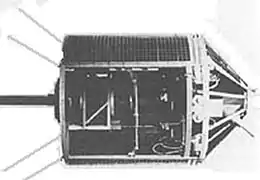Azur (satellite)
Azur (also called GRS-A) was West Germany's first scientific satellite. Launched on 8 November 1969 it studied the Van Allen belts, solar particles, and aurorae.[2] [3]
 | |
| Operator | BMWF/DLR |
|---|---|
| COSPAR ID | 1969-097A |
| SATCAT no. | 4221 |
| Mission duration | 7 months |
| Spacecraft properties | |
| Manufacturer | BMWF/NASA |
| Launch mass | 71 kilograms (157 lb) |
| Start of mission | |
| Launch date | 8 November 1969, 01:52 UTC |
| Rocket | Scout B S169C |
| Launch site | Vandenberg SLC-5 |
| End of mission | |
| Last contact | 29 June 1970 |
| Orbital parameters | |
| Reference system | Geocentric |
| Regime | Medium Earth Decayed into Low Earth |
| Periapsis altitude | 368 kilometres (229 mi) |
| Apoapsis altitude | 1,445 kilometres (898 mi) |
| Inclination | 102.70 degrees |
| Period | 102.99 minutes |
| Epoch | 6 December 2013, 12:36:47 UTC[1] |
The construction of the satellite was carried out by Ludwig Bölkow, one of the aeronautical pioneers of Germany, and with the participation of other German companies.[4]
References
- "AZUR (GRS A) Satellite details 1969-097A NORAD 4221". N2YO. 6 December 2013. Retrieved 6 December 2013.
- "Azur". The Internet Encyclopedia Of Science. Retrieved 2009-07-19.
- "Azur, Aeros, and Dial-Wika satellites". Cooperative Institute for Research in the Atmosphere, Colorado State University. Archived from the original on December 1, 2008. Retrieved 2009-08-03.
- https://www.spacelegalissues.com/azur-the-first-german-satellite/
This article is issued from Wikipedia. The text is licensed under Creative Commons - Attribution - Sharealike. Additional terms may apply for the media files.